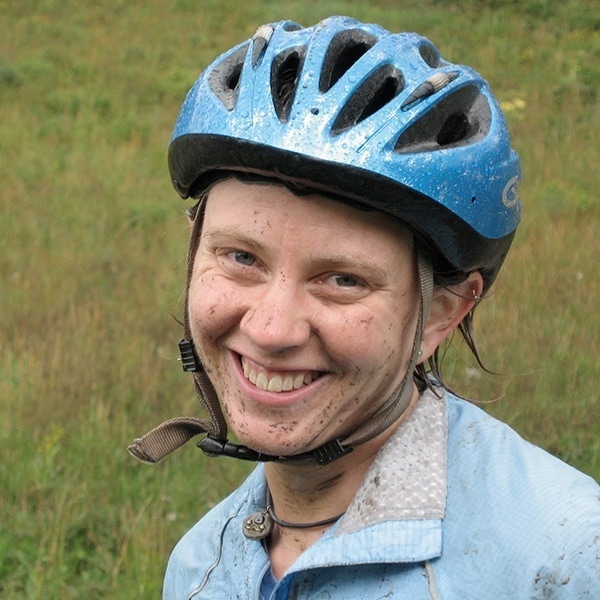There are few things better than spending a night under the stars—unless, of course, you're tossing and turning. The right sleeping bag can help with your next camping adventure.
Minimizing weight and bulk isn’t a big consideration for most camping-bag shoppers. Our roundup of sleeping bags for camping instead focuses on sleep sacks that offer a just-right combo of versatility, features and comfort for peaceful slumber.
To bring you the best ones sold at REI Co-op, we consulted our retail specialists and staff and pored through dozens of customer reviews. There's a sleeping bag for most people on this list, whether you're camping for the first time, outfitting your kiddo, adventuring on a budget or looking for a sleep sack big enough for two. Read on for our favorites.
Staff Picks
Find quick recommendations below or scroll down for in-depth reviews.
- REI Co-op HunkerDown 20 Sleeping Bag
- Coleman Arch Bay 30 Sleeping Bag
- REI Co-op Trailmade 20 Sleeping Bag
- REI Co-op Siesta Hooded 20 Sleeping Bag
- Big Agnes Echo Park 0 Sleeping Bag
- Exped MegaSleep Duo 25/40 Double Sleeping Bag
- REI Co-op Kindercone 25 Sleeping Bag - Kids'
- Rumpl Original Puffy Blanket
- REI Co-op Magma 30 Down Trail Quilt
Editor's Note: We updated this gear guide on June 3, 2025, to include an updated version of the REI Co-op Siesta 20 Hooded Sleeping Bag. We also added buying guide information.
REI Co-op HunkerDown 20 Sleeping Bag
Temperature rating 20 degrees (F)
Insulation Down
Fill 600-fill-power down (RDS certified; bluesign® approved)
Weight Medium
Versions Medium, Medium Wide, Long, Long Wide
Sustainability features Contains materials that meet the bluesign® criteria, contains recycled materials, contains down certified to the Responsible Down Standard (RDS), from a Climate Neutral Certified brand
Best for Versatility, restless sleepers
Three-season warmth, thoughtful features and spacious geometry (thinking of you, side sleepers) make the REI Co-op HunkerDown 20 a versatile pick for many types of campers.
Equipped with 600-fill-power down, the HunkerDown delivers no-nonsense warmth in temperatures as low as 20°F while still compressing (stuff sack included) into a cylinder just a hair over 9 liters (or about the size of an average camp pillow). An oversized hood keeps pillows of all sizes in place (including your favorite headrest from home), while the built-in draft collar retains your body heat if temps dip in the night—and if they don’t, a wraparound zipper offers plenty of ways to ventilate. In keeping with the REI commitment to the planet, the HunkerDown 20 features Bluesign®-approved down insulation, polyester lining and recycled polyester shell.
Because the HunkerDown 20 features a more traditional, rectangular geometry, there’s ample room for those who shift and shimmy in their sleep, points out Elizabeth Nguyen, senior retail specialist in the camping department at the REI store in Atlanta, Georgia. (Learn more about sleeping bag geometry options here.) Multiple customer-reviewers agree, including one from Spokane, Washington: “I sleep on my side with an inflatable pillow between my knees, and this bag has enough room to allow that.” Another customer-reviewer says the bag “had plenty of room” for their 5-foot-10-inch frame.
While this bag isn't the lightest or most compressible option in our lineup, it appeals to campers across experience levels: Its less-restrictive silhouette (compared to a mummy-shaped bag) makes the HunkerDown 20 a great option for those newer to camping who want comfort and movement. Its three-season warmth appeals to more experienced campers who go out more often.
“That HunkerDown 20 title is well-earned,” says Carlos Rodriguez, department manager at the REI store in Wichita, Kansas. He gushes over the way the down molds into his body, adding “I have to give [it] a Carlos, double thumbs up. If you’re saying you can only pick one, the HunkerDown 20 is it. That is an extension of my home.” Buy here.
Coleman Arch Bay 30 Sleeping Bag
Temperature rating 30 degrees (F)
Insulation Synthetic
Fill Ecotherm
Weight 6 lbs. 5.6 oz.
Versions One size
Sustainability features Contains recycled materials
Best for Beginner campers
New to camping? The roomy Coleman Arch Bay 30 Sleeping Bag will help you feel right at home. The bag’s rectangular silhouette—which is a spacious 81 by 33 inches—provides room to stretch. It’s also built with a trifecta of stay-warm attributes like a draft tube on the zipper to prevent heat loss, a cozy cuff at the neckline and fully recycled Ecotherm™ fill that keeps users warm on chilly evenings. That temperature rating works well for beginners, who are more likely to try camping for the first time during spring, summer and autumn months, says Nguyen, senior retail specialist in the camping department at the REI store in Atlanta.
Packing up is also a little easier with this sleep sack. Tiny clasps at the edges of the bag allow you to secure it in place before you pack it. Just fold the bag lengthwise, fasten the two sides together, then roll.
The Arch Bay 30 is simpler than other sleeping bags out there (you won’t find stash pockets or a cinch collar, for example), but thoughtful touches like a contoured layer of fabric above the neckline to keep your head or pillow in place and a ZipPlow zipper to prevent frustrating fabric snags contribute to the bag’s 4.7-star user-review rating (at the time of this writing). Those just-enough features combined with an approachable $80 price point make it the perfect starter bag for someone new to camping or loves slumber parties. Buy here.
REI Co-op Trailmade 20 Sleeping Bag
Temperature rating 21 degrees (F)
Insulation Synthetic
Fill Polyester (98% recycled; bluesign approved)
Weight Short - Left Zip
Versions Short, short wide, regular, regular wide, long, long wide
Sustainability features Contains materials that meet the bluesign criteria, from a Climate Neutral Certified brand
Best for Value, inclusive sizing
Saving money on gear can come at the expense of comfort, weight or warmth—not with the REI Co-op Trailmade 20.
“[The Trailmade bags] are really good, economical bags,” says Rodriguez, department manager at the REI store in Wichita, Kansas.
The three-season sleeper is slightly broader in the shoulders compared to more traditional mummy bags, while still delivering a warmth-boosting, weight-reducing kick. A cinchable face muffler, full draft tube and offset quilt construction (this means two or more layers of insulation are layered to prevent cold spots) work together to keep users toasty on chilly nights. Since rainy days are always a possibility in the backcountry, the bag features water-resistant, recycled synthetic fill along with a durable water repellent (DWR) finish on the recycled polyester shell.
A contoured hood designed to cradle your noggin (or your favorite camp pillow), snag-resistant zippers and an external, zippered pocket placed high on the chest (great for stashing a phone or headlamp) are nice-to-have features. One of our editors appreciated love the long pulls on the zippers, which made it easy to find in the dark. While her campmate complained of feeling some condensation the next morning, she didn't experience that in the Trailmade.
Like all Trailmade apparel and gear, the Trailmade 20 Sleeping Bag is created with “inclusivity, simplicity, approachability and functional design” at the forefront. (Read more about it here.) Case in point: This bag comes in six different size options, depending on the user’s preferred bag height and width.
“While it certainly isn’t an ultralight bag, its weight still comes in under 4 pounds, even for the long-wide version,” says Tim Bird, department manager at the REI store in Farmington, Utah. “All of that for right at $100? It’s tough to beat.” Buy here.
REI Co-op Siesta Hooded 20 Sleeping Bag
Temperature rating 20 degrees (F)
Insulation Synthetic
Fill 98% recycled polyester/2% polyester (bluesign® approved)
Weight 5 lbs. 7.3 oz. (Medium), 5 lbs. 15.6 oz. (Medium Wide), 5 lbs. 14.9 oz. (Long), 6 lbs. 7.5 oz. (Long Wide)
Versions Medium, Medium Wide, Long, Long Wide
Sustainability features Contains recycled and bluesign®-approved materials
Best for Comfort, warmth
This sleeping bag probably deserves its own fansite. “People come in asking for the Siesta,” says Jenny Askey, an outfitter at the REI store in Boulder, Colorado. “It’s an outstanding bag, given its features and price point.” Costing $30 to $50 less than comparable bags, the REI Co-op Siesta 20 wins devotees by combining a roomy, rectangular shape with a mummy bag’s hood. “That lets it trap heat like a mummy, while also giving sleepers freedom to move,” explains Adam Bernardini, another outfitter at the Boulder REI store. The Siesta comes in four sizes to fit the full spectrum of body types—meaning campers are virtually guaranteed to find a version that provides a blissfully cozy night’s sleep. (There’s also a double-size version.)
The spacious hood accommodates a full-size pillow from home or a camp pillow, and tightening its cinch cord keeps out chilly drafts. Meanwhile, zippers on both ends of the bag allow for bedlike versatility: The foot area can be partially unzipped to improve air flow or fully unzipped so the bag spreads out like a quilt, while two side zippers at the shoulder allow the top of the bag to fold down like a bed sheet (convenient for reading and anytime you want your arms outside the bag).
The soft lining and shell fabrics are treated with a nonfluorinated durable water repellent (DWR) finish to repel tent-wall condensation or coffee spills. And the offset quilt construction excels at warmth, securing the synthetic fill by stitching one sheet of insulation to the shell fabric and a second sheet to the lining using staggered seams that don’t overlap. That eliminates the cold spots that are common among single-layer baffles with stitch-through seams.
As for downsides? The spacious cut and synthetic insulation (which isn’t as compressible as down) make the Siesta heavier and bulkier than backpacking-optimized bags. But for car-campers who prioritize comfort over packability, the Siesta feels like home. Buy here.
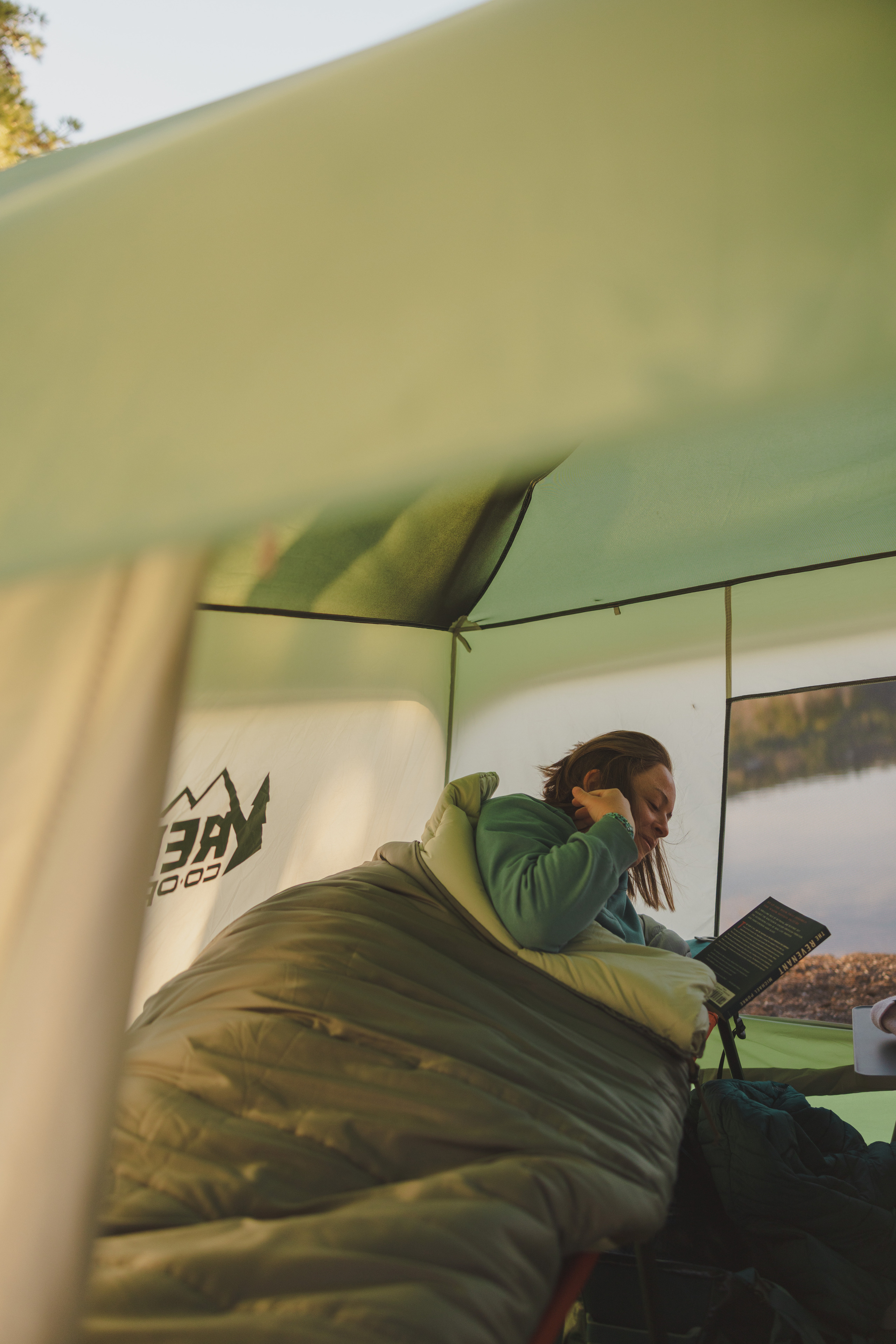
Big Agnes Echo Park 0 Sleeping Bag
Temperature rating 0 degrees (F)
Insulation Synthetic
Fill FireLine Max Eco
Weight 5 lbs. 15.6 oz.
Versions Long wide
Best for Winter camping, camping with pets
Not a fan of cold-weather camping? This sleeping bag might change your mind.
The Echo Park 0 was built specifically to be a “cozy oasis of comfort when the temps drop,” says Cory Barbiere, senior product designer for Big Agnes.
This is thanks to simple yet impactful design touches. For instance, where many sleeping bags use a slippery polyester lining, the Echo Park 0 interior is a polyester-cotton blend that ensures the bag doesn’t feel cold to the touch when the user first snuggles in. The proprietary FireLine synthetic insulation uses both hollow and solid polyester fibers to add comfort- and warmth-enhancing loft. Plus, using synthetic insulation instead of down means the bag remains warm even if liquid gets past the exterior’s water-repellent finish.
The Echo Park 0’s oversized fit was another intentional choice, Barbiere says. The sleeping bag is large enough to accommodate wearing extra layers to bed, using a sleeping bag liner, stashing a hot water bottle in the foot box or even inviting in a furry friend to cuddle. The specialized collar and zipper, along with a hood designed to cinch around the user’s head, keep drafts at bay, while two hand pockets inside the top corners make it a breeze to pull the bag’s neck up around your own. Finally, a sleeve system on the back connects to your sleeping pad to prevent unconsciously shimmying off and ending up on the cold ground during the night.
Other features to love: an internal stash pocket, a so-called “pillow barn” to keep your headrest in place and double zippers that not only facilitate entry from both sides of the bag but allow the Echo Park 0 to transition into a camp blanket. Storage and stuff sack included. Buy here.
Exped MegaSleep Duo 25/40 Sleeping Bag
Temperature rating 25/40 degrees (F)
Insulation Synthetic
Fill 100% recycled TEXPEDLOFT polyester
Weight 8 pounds
Versions One size
Best for Sharing, versatile warmth
Exped might have more aptly named the MegaSleep Duo the "Quatro": You're getting a bag that can be deployed as a 25° double bag, a 40° double bag, a 25° single bag or a 40° single bag. It can also be used as two camp blankets. It's another well-loved pick among several of our staffers, too, and it's easy to see why a bag that offers this much versatility would garner this much love.
Karen Cutter, a sales lead at the REI Knoxville, Tennessee, store, explains why this Exped bag's concept works so well for her. "I did this exact same thing in the past by buying two sleeping bags with different temperature ratings. Depending on the weather, we'd flip the warmer side up or down. I loved that versatility." Cutter also adds: "With the Exped, you can also create two separate sleeping bags, which you can't do with a traditional double bag. So, the fact that you can create two separate bags and you have the temperature range—I just think that's awesome."
Matthews agrees, and is especially impressed with the simplicity of temperature adjustment: "All you have to do is flip it on over." Matthews also approves of the brand's performance over the years: "Exped's quality shines in all their gear."
Sarah Miller, a sales manager at the REI store in Marina, California, points to the story the specs tell: "Width can really play into how much people like a double bag, and this is one of the widest options (133.9 inches at the shoulders) available." The bag's microfiber insulation is indeed extraordinarily light and compressible for a synthetic fill.
"It also has a fun little (duffel bag) carrying case," she says. "Who doesn't love that?" Buy here.
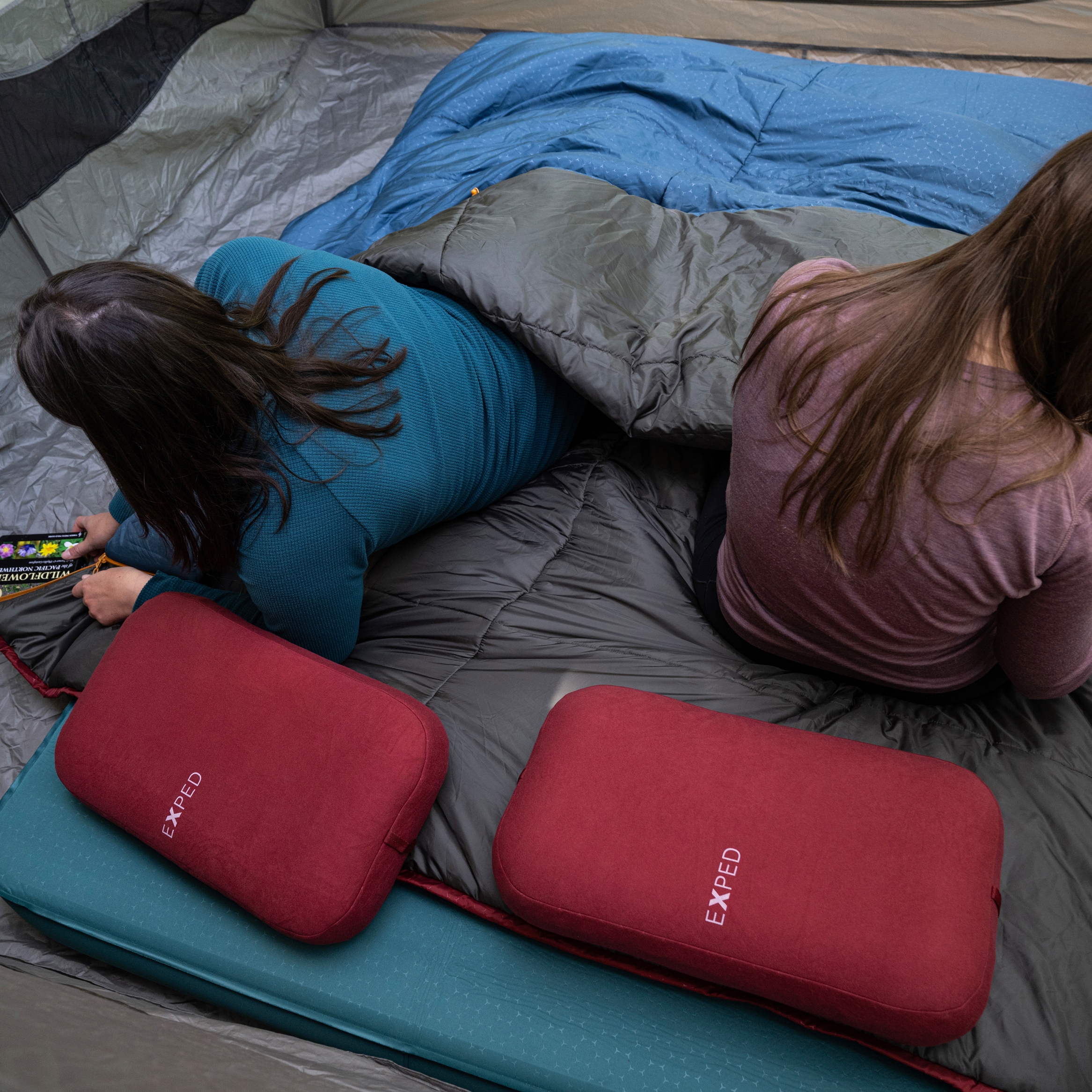
REI Co-op Kindercone 25 Sleeping Bag - Kids'
Temperature rating 25 degrees (F)
Insulation Synthetic
Fill Polyester fibers
Sustainability features Contains recycled materials and materials that meet the bluesign® criteria; from a Climate Neutral Certified brand
Best for Growing kids, camping, backpacking
Buying a single bag for both camping and backpacking makes perfect sense when it's a kids' sleeping bag. A child's preference for camping over backpacking—or vice versa—isn't fully formed yet. They're also going to outgrow any gear you buy in a few years. The co-op's venerated Kindercone backpacking bag is the perfect answer—it comes with built-in growth-spurt insurance. The included stuff sack, which is attached to the bottom of the bag so you won't lose it, can be cinched to make the bag shorter when your child is younger; as your child grows, simply move the cinch point down to lengthen the bag.
Kindercone, which in various iterations has been in the REI Co-op sleeping bag line for more than two decades, has just the right mix of toughness and tech required in a kids' bag. The sturdy shell and two-way antisnag coil zipper resist rough use, while its polyester materials offer resistance to spills and drizzle. The Kindercone is estimated to provide warmth down to 25°F, which should help kids stay comfortable, even on a cool-weather trip. "The slim shape isn't merely a backpacking advantage; it's also a warmth advantage because a kid's small body doesn't have to work so hard to heat the bag up," noted one of our retail sales managers.
Because the sleekly built Kindercone tips the scales at just a hair over 3 pounds, budding backpackers should also be able to carry their bag—just like their adult trip leaders.
Even the material choices in the Kindercone consider your child's future. Both the shell and lining are recycled polyester that's certified to meet bluesign® criteria. Buy here.
Rumpl Original Puffy Blanket
Insulation Synthetic
Versions 1-person and 2-person
Weight (1-person) 2 lbs. 1.6 oz.
Weight (2-person) 3 lbs. 13 oz.
Sustainability features Contains recycled materials, from a Climate Neutral Certified brand
Best for Around-camp comfort, wheelchair users
Admittedly, a blanket is an outlier in an article devoted to sleeping bag picks, but Rumpl has created such a beloved piece of gear that we couldn't leave the brand's blankets out of our roundup. Campers use them as a campfire shawl, an impromptu ground cover and, of course, another layer of warmth in their sleep systems. Wheelchair campers often use blankets for their sleep setups, too, because sleeping bags can be hard to manage with limited leg mobility.
Sarah Miller, a sales manager at the REI store in Marina, California, also points out that a Rumpl works just about anywhere: "It's a camp blanket and it's an office blanket." Miller also explains that Rumpl's many water-resistant flavors work well in both environments: "I spilled so much stuff on that blanket, and still it has persisted. You just wipe it right off and continue." (Miller also got a Rumpl for her partner to use in his office.) The Original Puffy version is machine washable.
Cutter says that her Rumpl was one of the first purchases she made after becoming an REI employee. She loves the blanket's practicality: "Because it's a sleeping-bag material, it's great around camp because it doesn't pick up any dirt or grass." Cutter is also impressed with the warmth: "The second you put it around your body, you can feel it starting to heat up. It's super cozy."
The Rumpl might also be available in more versions than any other camping gear. The Original Puffy version has a synthetic material and fill, both of which are made using recycled materials. There's also a Backcountry Puffy. Rumpls come in two basic sizes: 1-person (72" x 52") and 2-person (84" x 80"), plus a travel size (52" x 38"). Most of the variations involve pattern and color: The product page looks more like an art gallery than a gear assortment. Buy here.
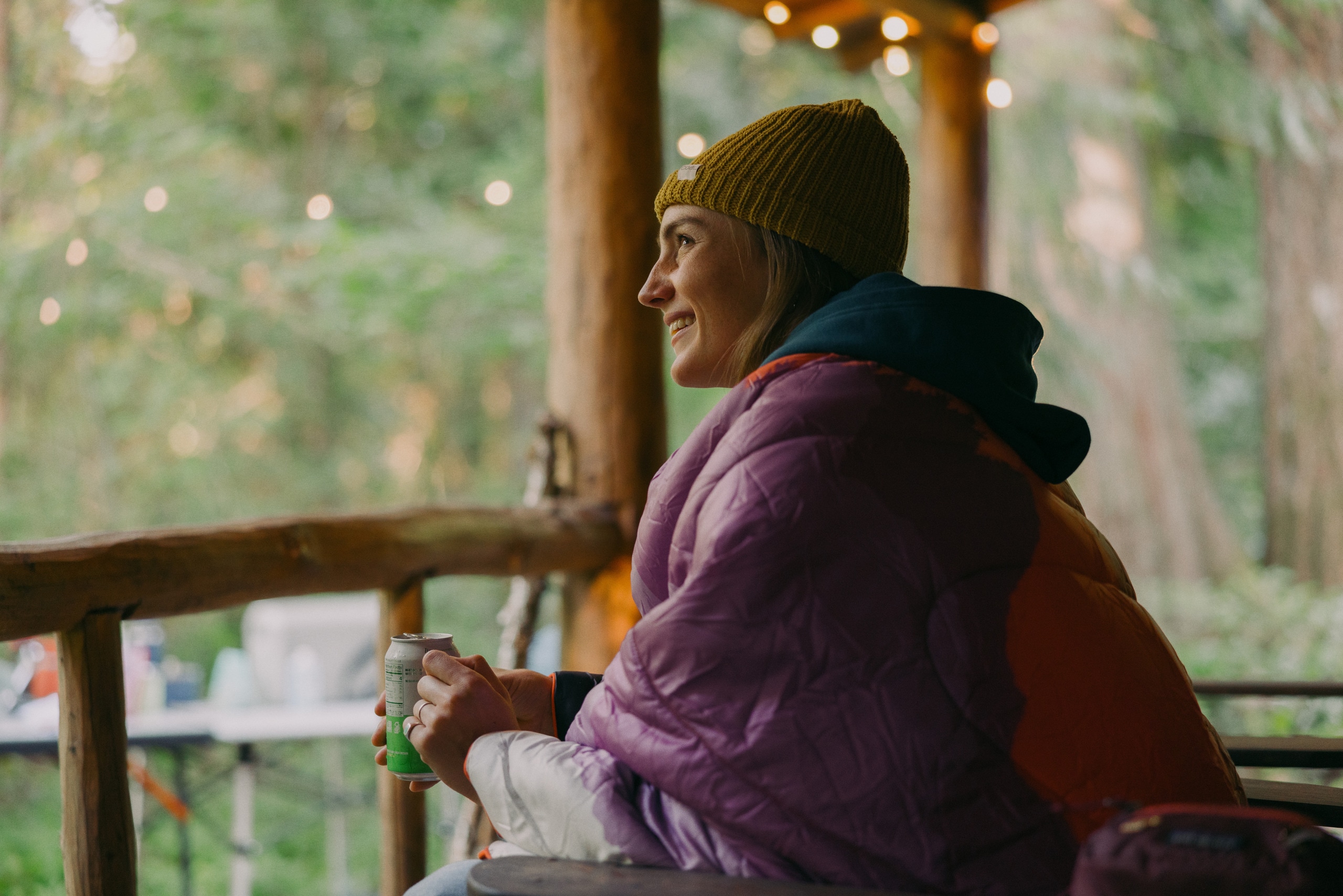
REI Co-op Magma 30 Down Trail Quilt
Temperature rating 30 degrees (F)
Insulation Down
Fill 850-fill-power water-resistant goose down (bluesign approved)
Weight Medium
Versions Medium, medium wide, long, long wide
Sustainability features Contains recycled materials, contains materials that meet the bluesign® criteria, from a Climate Neutral Certified brand
Best for Camping, backpacking, minimalists
Our experts sing the praises of the REI Co-op Magma 30 Down Trail Quilt, pointing to its minimal weight (just 1 pound 8.5 ounces for the long-wide version) and ability to squish down to roughly the size of a Nalgene water bottle.
Water-resistant, 850-fill-power goose down and 15-denier recycled ripstop nylon in the shell help trap heat to earn the Magma a 30°F temperature rating. A nonfluorinated durable water repellent (DWR) finish on the shell helps keep the fabric dry so it can retain warmth in rainy conditions. That impressive list of features earned the Magma 30 a spot in the minimal backpacking setup of Tim Bird, department manager at the REI store in Farmington, Utah. In 2021, Bird pedaled 187 miles around Lake Tahoe with the quilt. He continues to be impressed by how such a lightweight bag can stand up to the rigors of the trail. “I’m generally pretty tough on my gear,” he says, “but the Magma 30 is still warm, compressible and allows me to move around quite a bit without feeling cold or restricted. And my quilt still looks practically new.”
Worried about losing your quilt as you sleep? Not with the Magma 30. Two pad cords help keep this top layer in place. For added warmth, create a toe box using the zipper-and-cinch attachment at the quilt's bottom.
Carlos Rodriguez, department manager at the REI store in Wichita, Kansas, addresses the higher price point. At $329, it’s one of the more expensive options in this lineup, but Bird says the features that make it light weight, compressible, breathable and warm are well worth the investment. Buy here.
Buying Advice for Camping Sleeping Bags
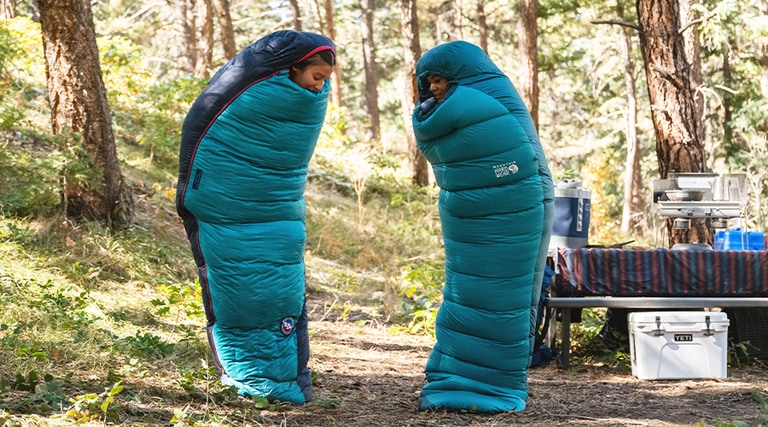
When the vehicle is doing the heavy lifting, weight is not a pressing issue, which simplifies your choices in a car-camping sleeping bag. You can simply pick the warmest, roomiest bag in your price range. (If you have a small car or a big family, though, then bag bulkiness also merits consideration.)
Many people come to the co-op and ask for a bag that can be used for backpacking, too, which saves money but involves compromised performance for one activity or the other. Your wisest course of action in that scenario is to pick your best bet for backpacking, which will be a bag you can also use for camping. More backpacking bags now offer roomier shapes, too, which many campers prefer. (For a rundown on all the things to consider in a sleeping bag for the backcountry, read How to Choose Sleeping Bags for Backpacking.)
For detailed buying advice for your campground adventures, read How to Choose Sleeping Bags for Camping. Below are some tips to consider when choosing a camping bag.
Temperature Rating
Insulation in a bag is key to how warm it will be, but factors like how snug it fits also matter. Sleeping bags keep you warm by retaining heat emitted by your body. It's easier and more efficient to warm a small space than an expansive space. Generally, roomier bags make it harder for your body to keep warm. This is important to know if you plan on buying one bag for both backpacking and camping. Camping bags tend to be roomier and maximize comfort, whereas backpacking bags are a balance of warmth, weight and comfort.
Bag makers provide temperature ratings, which is helpful, though the ratings you see on camping bags should only be used as a rough guideline. (For a thorough overview of how bag warmth is measured, read about understanding sleeping bag temperature ratings.)
When you shop, look for a bag that will keep you warm at a temperature that’s slightly lower than the lowest nighttime temperature you might possibly encounter on your trips. Many people err on the side of getting extra warmth, too, because they always have the option to shed layers or to unzip their bag in milder conditions. The Big Agnes Echo Park 0 Sleeping Bag is ideal for cold-weather camping because it has a temperature rating of 0 degrees. On the opposite end, we included the Rumpl Original Puffy Blanket as an option for those who sleep warm or just want an extra blanket. Meanwhile, with the Exped MegaSleep Duo 25/40, you can easily switch between two different warmth options.
Perhaps the most common complaint is that a given bag failed to keep the customer warm down to its stated temperature rating. A wide range of factors go into warmth (like how cold or warm a person sleeps), so think of the rating as a guideline rather than an absolute guarantee.
Sleep Systems
One of the biggest keys to your warmth is the sleeping pad you pair with your sleeping bag. Your pad/bag combo is your sleep system, which gives a more accurate picture of how warm you’ll sleep.
If you use a less-insulated pad at colder temps, your sleeping bag might not live up to its temperature rating. In order to get the bag’s tested warmth, you also need to have a sleeping pad with the appropriate R-value rating. To learn more about pad warmth ratings and get a look at how bags and pads work in tandem to keep you warm, read How to Choose a Sleeping Pad.
Sleeping Bag Shape
If you’re like most campers, you’ll want a bag that offers room enough to stretch out and roll over. A simple rectangular design works well for that, but camping bags have evolved and you have a variety of shapes to choose from:
Rectangular: These bags give your arms and legs plenty of room to stretch out and move around. The REI Co-op HunkerDown 20, REI Co-op Siesta Hooded 20 Sleeping Bag, Coleman Arch Bay 30 and Exped MegaSleep Duo 25/40 Double are rectangular bags.
Semirectangular: Also known as a “modified mummy” or “barrel” shape, this designation covers a variety of shapes, all of which offer a compromise between warmth and roominess. The Big Agnes Echo Park 0 is semirectangular bag.
Mummy: Found mostly in backpacking bags where warmth and low weight are key factors, this bag style has a snug fit. The REI Co-op Trailmade 20 and REI Co-op Kindercone 25 are mummy bags.
Double sleeping bags: Bags made for two are the best bet for couples who plan to sleep together. Our double bag pick for this article is the Exped MegaSleep Duo 25/40, which also offers the option of turning it into two single bags. (An alternative way to create a double bag is to purchase two bags that are designed to be zipped together.)
Type of Insulation
Down or synthetic? Sleeping bags with synthetic insulation offer solid performance at lower cost than down. Many campers also prefer a synthetic fill because, unlike untreated down, it retains its insulating ability in damp conditions. Most of the camping bags in this article use synthetic insulations.
In comparison to synthetic insulation, sleeping bags with down fills are warmer for their weight, lighter and more compressible—and have a higher price tag. The two sleeping bags that use down are the REI Co-op Magma 30 Down Trail Quilt and REI Co-op HunkerDown 20.
What's a Camp Quilt?
We included a camp blanket and camp quilt on this list as options for people who sleep warm, want an extra layer or crave a more versatility with their sleep system. Read on to learn the differences between a camp quilt, a camp blanket and a sleeping bag.
Camp Quilts versus Camp Blankets
At first glance, it’s easy to assume a camp blanket is the same as a camp quilt. Dig deeper, though, and there’s a very important difference.
“A connecting interface from the quilt to the pad is really the differentiator for what we consider a camping quilt versus a blanket,” explains Bird, department manager at the REI store in Farmington, Utah. “The quilt attaches to the sleeping pad, whereas a blanket is an insulated rectangle that you can throw over yourself.”
Camp quilts also tend to have more technical features—for example, enclosed toe boxes, zippers, extra insulation and ultralightweight materials. Quilts are a great choice if you’re a restless sleeper because many include attachments that hold the quilt tight to the sleeping pad to keep it in place as you toss, turn and wriggle in the night. If your quilt doesn’t come with a cord attachment, you can buy elastic pad straps for extra security. Quilts can also be a warmer option than a camp blanket because, depending on the style you chose, they offer more coverage.
Camp blankets, on the other hand, are perfect for warmer nights when you want a layer more for comfort than for actual warmth. With a camp blanket “you have no traction,” Bird says, referring to the slippery nylon fabrics used for many camp blankets and sleeping pads. “It’s tough to keep it on yourself unless it’s a really oversized blanket or unless you’re a really still sleeper.”
Camp Quilts versus Sleeping Bags
A quilt can also be a great alternative to a sleeping bag for campers who sleep hot, are camping in warmer weather or like to adjust their temperature throughout the night. For instance, you can use a quilt as a top layer or secure it to a sleeping bag for more coverage. It’s also easier to ventilate when you have only a top layer, Since quilts have less fabric than a sleeping bag, they also tend to be less heavy—great for campers who also want a light option for backpacking.
Related reading: Sleeping Bags vs. Quilts: Which is Right for You?
Our Process
We chatted with several REI Co-op staffers, including seasoned REI retail sales specialists and managers who know their gear. We also reviewed dozens of customer reviews to pick the best sleeping bags in each category. These are their favorites camping sleeping bags for all adventures.
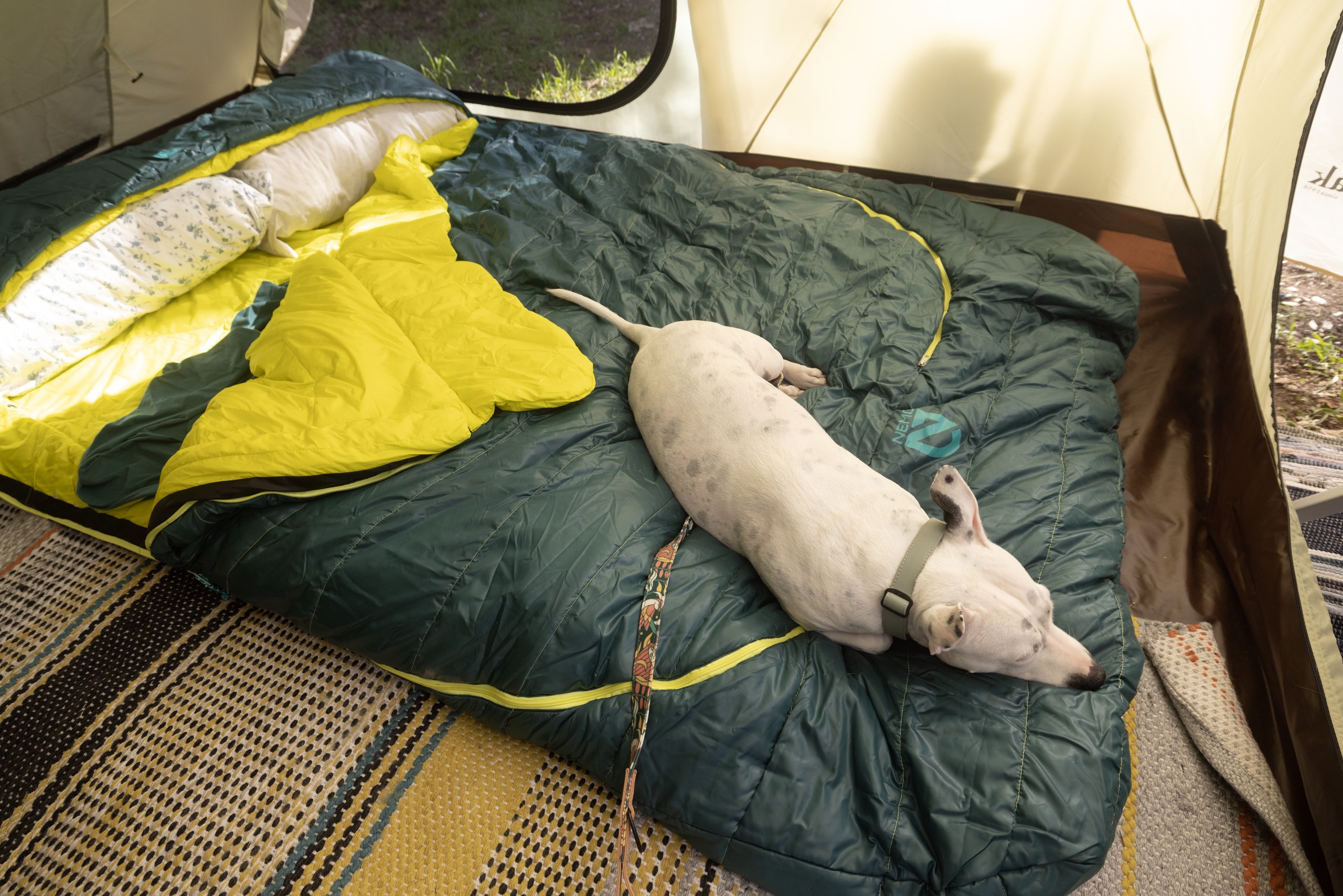











![Trailmade 20 Sleeping Bag [Full-length view, zipped (Balsam Teal)]](/media/c048f905-f6b0-48a1-81dc-826da69556b6/?size=440)
![Trailmade 20 Sleeping Bag [3/4 head view (Balsam Teal)]](/media/dc58aaab-0c8e-4cea-b68e-d6bc5c425d96/?size=440)
![Trailmade 20 Sleeping Bag [3/4 foot view (Balsam Teal)]](/media/deccd580-5aed-4020-be44-513235b7c0b1/?size=440)
![Trailmade 20 Sleeping Bag [Hood detail (Balsam Teal)]](/media/25ad3664-78f9-4ebf-95e9-f34d63072851/?size=440)







![Echo Park 0 Sleeping Bag [Sleeping pad not included]](/media/0080b809-0d95-4a4b-a134-f66be3ea81c9/?size=440)

![Echo Park 0 Sleeping Bag [Sleeping pad not included]](/media/7d6c0a66-e8ab-49f6-b65d-b498be76d9d0/?size=440)

![MegaSleep Duo 25/40 Sleeping Bag [Cool weather side]](/media/6cbdaccb-6174-4ae7-bc69-8469a26d8bf1/?size=440)
![MegaSleep Duo 25/40 Sleeping Bag [Interior head detail]](/media/b7a74588-3545-4227-81f2-1452856fd96d/?size=440)
![MegaSleep Duo 25/40 Sleeping Bag [Warm weather side]](/media/251eb2af-ed08-461e-891c-93c7be887930/?size=440)

![Kindercone 25 Sleeping Bag - Kids' [Full length zipped]](/media/ab29ff1e-1b77-49c3-8007-2938cd903237/?size=440)
![Kindercone 25 Sleeping Bag - Kids' [Hood detail]](/media/4dda578a-b380-4ad2-b03e-c03abe794f15/?size=440)
![Kindercone 25 Sleeping Bag - Kids' [Zipper detail]](/media/bd572b80-9892-4634-ae9d-577a7ba1d078/?size=440)
![Kindercone 25 Sleeping Bag - Kids' [3/4 head view]](/media/37d98ec9-f81f-4c3a-b17a-03ff2f58c0ee/?size=440)




![Original Puffy Blanket [Folded view]](/media/67fa42a5-10f3-41a4-8b4e-e6a1a53d4c09/?size=440)


![Magma 30 Down Trail Quilt [Pad not included]](/media/00ca2e7e-dd32-4e24-a327-bec45a008f18/?size=440)
![Magma 30 Down Trail Quilt [Pad not included]](/media/e4490180-37e5-4553-a0a7-f3aeb1b3acb2/?size=440)

